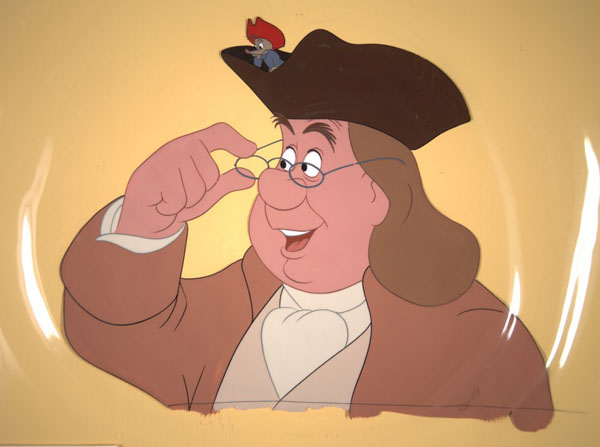
During his introduction to the weekly Disneyland television show entitled The Liberty Story that originally aired on May 5, 1957 Walt walked over to his magical bookcase in the soundstage set that mimicked his real formal office. However, this time there was a smaller bookshelf attached to one of the shelves.
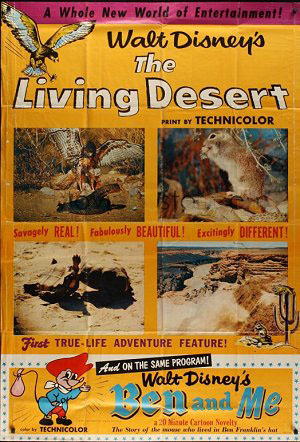 Walt explained that these books had been located in a church basement when it was being torn down and since the books seem to have been written by a mouse, that it was natural that they send the books to Walt.
Walt explained that these books had been located in a church basement when it was being torn down and since the books seem to have been written by a mouse, that it was natural that they send the books to Walt.
It was just part of a clever introduction to the animated featurette Ben and Me. Based on the popular 1939 book by Robert Lawson, Ben and Me tells the “true” story of the inventive churchmouse who was actually the real brains behind Benjamin Franklin and his many accomplishments.
Walt Disney purchased the rights to the book in 1946 and by 1947 rough storyboards had been prepared.
Ben and Me was originally released on November 10, 1953 as part of a package that included the live action seventy-two minute long True Life Adventures feature The Living Desert.
Walt felt that an animated featurette could be paired with a short live action feature to make a complete program of Disney entertainment.
Ben and Me was made in Technicolor and ran twenty-one minutes (it has also been released at a length of twenty-five minutes with additional animation done for the television presentation) and was considered the first Disney animated featurette (two reels) since it was almost three times as long as the usual Disney short cartoon.
Ben and Me was nominated for an Academy Award in the two reel short subject division. The winner for two reel short subject that year was Disney’s True-Life Adventure Bear Country. The winner for one reel short subject was Disney’s Toot, Whistle, Plunk and Boom.
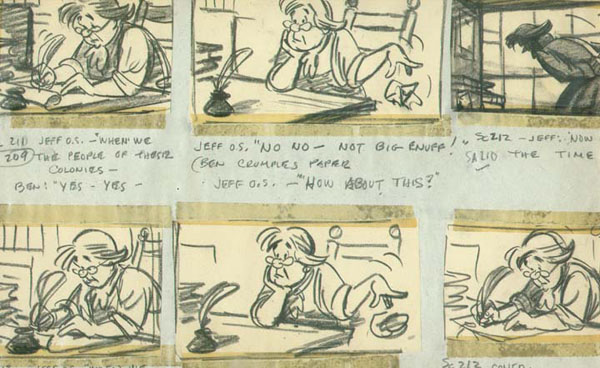
Famed Disney storyman Bill Peet did the primary adaptation with additional dialogue supplied by Winston Hibler, Del Connell, and Ted Sears. The adaptation kept fairly close to the source material but added some scenes and humor that helped expand and focus the slight story.
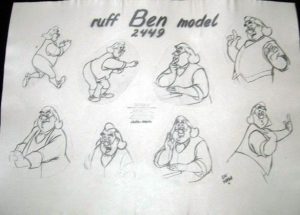 One significant change is that in an early chapter in the book, in order to get the assistance and advice of Amos, Franklin must agree to provide Amos large family with cheese, rye bread and wheat on a regular basis.
One significant change is that in an early chapter in the book, in order to get the assistance and advice of Amos, Franklin must agree to provide Amos large family with cheese, rye bread and wheat on a regular basis.
Peet changes it into a contract near the end of the film that will give the mouse respect and not be subject to experimentation and humilation. The contract as written by Amos inspires Thomas Jefferson to write the Declaration of Independence using the exact same words.
The film was directed by Hamilton Luske. Luske had joined the Disney Studio in 1931 as an inbetweener and became an animator in 1934 on the Silly Symphonies.
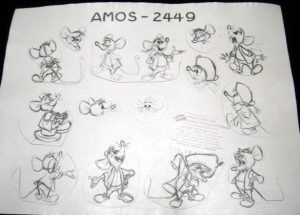 At the time Ben and Me was made, he was a sequence director on the animated feature film Peter Pan and was moving into being a sequence director on the animated feature Lady and the Tramp. Luske’s directorial assistant on Ben and Me was Rusty Jones.
At the time Ben and Me was made, he was a sequence director on the animated feature film Peter Pan and was moving into being a sequence director on the animated feature Lady and the Tramp. Luske’s directorial assistant on Ben and Me was Rusty Jones.
Animators who worked on the film included Wolfgang Reitherman, Ollie Johnston, John Lounsbery, Hal King, Cliff Nordberg, Les Clark, Marvin Woodward, Don Lusk, Hugh Fraser, Jerry Hathcock, Eric Cleworth, Harvey Toombs, Hal Ambro, Merle Gilson, Milt Kahl, Eric Larson, Bob McCrea, and Art Stevens.
Dan McManus did some effects animation and art direction was by Ken Anderson and Claude Coats. Backgrounds were by Al Dempster, Thelma Witmer, and Dick Anthony. Oliver Wallace did the music.
Sterling Holloway is the only voice credited on the film. According to Disney Archivist Dave Smith, Holloway, Hans Conried, Bill Thompson, Charlie Ruggles, and Stan Freberg were all in to record voices for the film during January 1952, but the files do not specify which roles they recorded.
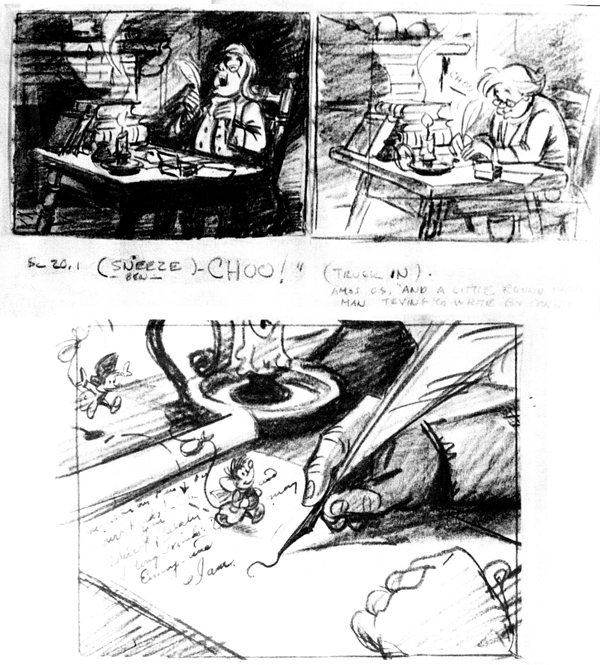
However, their voices are so distinctive, it is easy to tell that Holloway did the voice of Amos Mouse who narrated the story, Charlie Ruggles was a genial Ben Franklin, Hans Conried (who had just finishing voicing Captain Hook for Peter Pan) was a fiery Thomas Jefferson, Bill Thompson (who had just finishing voicing Mr. Smee for Peter Pan) was the guide at the beginning of the featurette as well as Governor Keith and some bit roles, and obviously the talented Stan Freberg filled in some miscellaneous parts as well.
While Charles “Charlie” Ruggles was recording the voice of Ben Franklin, he was appearing on his television show, The Ruggles (1949-1952). The show featured Margaret Kerry as his teenaged daughter. At this time, Margaret had just recently done live action reference modeling for the role of Tinker Bell in Peter Pan.
Years later, Ruggles appeared in several live action Disney films including The Parent Trap (1961), Son of Flubber (1963), The Ugly Dachshund (1966) and Follow Me Boys (1966).

Although Sterling Holloway’s first Disney work was as the messenger stork in Dumbo (1941), Walt Disney was apparently aware of Holloway’s work on radio since — in a memo dated August 9, 1934 — he recommended Holloway as the voice of Sleepy in Snow White and the Seven Dwarfs (1937). The part eventually went to Pinto Colvig.
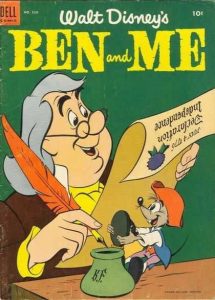 Despite his many memorable voices for Disney characters like Kaa, Winnie the Pooh and the Cheshire Cat, Holloway was also a narrator of Disney cartoons like Peter and the Wolf. His first narration for Disney was as “Professor Holloway” in The Three Caballeros (1945) telling the story of “Pablo the Cold Blooded Penguin.”
Despite his many memorable voices for Disney characters like Kaa, Winnie the Pooh and the Cheshire Cat, Holloway was also a narrator of Disney cartoons like Peter and the Wolf. His first narration for Disney was as “Professor Holloway” in The Three Caballeros (1945) telling the story of “Pablo the Cold Blooded Penguin.”
New animation written by Peet and directed by Luske was added to The Liberty Story presentation on television.
The new animation, not based on anything in Lawsons book, is a prologue about the plight of the ancestors of Amos. In 1568, Christopher Mouse seeks refuge in the cellar of a London bakery in Fleet Street only to be denied access to a split open sack of flour by a fat, black cat (re-using animation of the cat Lucifer from Cinderella).
Jason Mouse, “the first real champion of the rights of mice”, is in 1620 London where mice are actually threatened by a mouse shortage because of the alarming number of cats. Jason prepares a petition demanding all cats be caged but it is ignored. Jason takes his family aboard a ship to the New World.
Amos obviously has a family history of radicalism. Amos and his family live in an old New England church vestry, Christ Church in Philadelphia, behind the paneling.
This “true mouse” version of the American Revolution remains an entertaining glimpse of the obvious “suppressed historical truth” of the situation. Apparently, when it came to the birth of the United States, it did indeed all start with a mouse.


 Jim Korkis is an internationally respected animation historian who in recent years has devoted his attention to the many worlds of Disney. He was a columnist for a variety of animation magazines. With his former writing partner, John Cawley, he authored several animation related books including The Encyclopedia of Cartoon Superstars, How to Create Animation, Cartoon Confidential and Get Animated’s Animation Art Buyer’s Guide. He taught animation classes at the Disney Institute in Florida as well as instructing classes on acting and animation history for Disney Feature Animation: Florida.
Jim Korkis is an internationally respected animation historian who in recent years has devoted his attention to the many worlds of Disney. He was a columnist for a variety of animation magazines. With his former writing partner, John Cawley, he authored several animation related books including The Encyclopedia of Cartoon Superstars, How to Create Animation, Cartoon Confidential and Get Animated’s Animation Art Buyer’s Guide. He taught animation classes at the Disney Institute in Florida as well as instructing classes on acting and animation history for Disney Feature Animation: Florida.




















































Was “Ben & Me” the only animated “Two-Reeler” to be nominated for “Best Two-Reel Short Subject”?
Also, I should mention that the whole “Liberty Story” episode just came and went on my cable’s “Disney On Demand” section. Unfortunately, I have to call and order to get that section.
This is one of the best Disney cartoons. I wonder if they did any live action reference for Thomas Jefferson?
“Ben and Me” is available on DVD as an exclusive through the Disney Movie Club, although they don’t make it clear if it’s the 21-minute version or the 25-minute version.
I have “Ben and Me” in one of the Treasures tins; it’s the original version that goes straight from the tour guide to Amos leaving home. Have a faint memory of the ancestor segment when Disney Channel ran “The Liberty Story” (mostly a promo for “Johnny Tremain”); never knew it appeared anywhere but there. Did they reissue “Ben and Me” theatrically with that segment added?
Always enjoyed it, with two historical nitpicks: One, the modern firemen’s helmets. Two, bad-mouthing “Poor Richard’s Almanac”. The almanac, which appeared annually, was a bestseller for decades.
Anybody notice the resemblance to “Mouse on the Mayflower”? Rankin-Bass could well have stumbled into it unawares. “Mouse on the Mayflower” rigorously hews to the Rankin-Bass TV formula that had evolved. With the addition of American history they couldn’t held but track close to “Ben and Me” in the opening segments.
Yes, in 1989 there was a “Disney Mini Classics” VHS release that included the “Liberty Story” segment that was inserted right during the tour guide section at the beginning. The end of the video makes mention of the TV version being included during the end credits.
https://www.youtube.com/watch?v=kUcK4-cmuoU
I’ve seen it a lot of times,too. Amos and Roquefort from The Aristocats (197) must be Sterling Holloway’s ONLY mouse roles.
I remember that DTV (Disney’s takeoff on MTV music videos) used footage from Ben & Me for the Stevie Wonder song For Once In My Life.
Charles Ruggles also voiced Aesop in Jay Ward’s Aesop and son.
BTW,there is no Franklin statue anywhere near the Independence Hall area,let alone one with a bronze mouse on top. To see how Franklin is commemorated in Philly,visit the Franklin Institute,a science museum for all ages, located at 20th &the(Benjamin Franklin ) Parkway,. The statue is free to visit,though if going,one might want to devote a few hours visiting the museum proper,which has an admission charge. It is well worth it and one may live through a true Philadelphian Experience-a journey through the human heart! As a kid,I was terrified,as an adult I enjoyed it;as a parent it was fun+3 kids and I hope to bring a grandkid or two before my own heart stops ticking(this,after aorta replacement and blockage surgery). Good place to experience a Philadelphia pretzel,though don’t tell my heart doctor.
Actually I can think of two statues of Ben very near Independence Hall. There is one in the pediment of Library Hall on 5th Street, just below Chestnut, and there is one inside the Public Ledger Building, 6th and Chestnut Streets.
Of course there are at least another dozen scattered about center city and West Philadelphia.
There is a statue of Robert Morris on Walnut between 4th and 5th, which is pretty much where the cartoon statue of Ben is located.
I took the time to watch this through and am glad I did. Since I work as a tour guide in Philadelphia, guests sometimes ask me about this animated film. Another small glitch, though, during the printing scene. 18th century ink didn’t come in tubes and was not applied with rollers, it was beaten onto the type with leather covered beaters stuffed with lambswool. A small thing.
Do the miniature books Walt Disney shows actually exist?
Does anyone know if RCA Victor Y/WY469 Ben And Me actually released? Was a single disc in picture cover 78 and 45 versions.
Correction-Number to RCA Ben and Me is Y/WY471
Ben And Me was released by RCA Victor as a single and as an extended play 45 with Stormy (EYA32). This record was in print for a very short time. Took me a long time to locate a copy. It does not us any of the voices on the film itself.
Brilliantly animated & a very handsome production all-around. By this time in the studio’s history, the animators had become truly expert at depicting humans in a highly realistic manner. While it strays quite a bit from the original book, it’s a delightful film, beautiful to watch for its artwork alone, based on a clever, though fictional, premise.
I remember this short and yes it does a great job representing Dr Franklin’s career but from Amos’ point of view, making it kinda like the American version of Ratatouille. The only negative that could have been better is the historical inaccuracy despite being done for dramatic purposes. It’s odd that Ben’s son, William wasn’t even included as he helped his dad experience electricity. The ending was a bit off because John Adams wasn’t included as he should have since he helped Thomas Jefferson write the Declaration of Independence. If he were to appear, I bet this could have reunited Bill Thompson with Hans Conried, as these two would have worked out well as Jefferson and Adams because of their roles as Captain Hook and Mr. Smee in Peter Pan and in the deleted song of Sleeping Beauty as the two loyal, yet grumpy kings, Stefan and Hubert. I think John Hancock could have also appeared at the end reading the Declaration as Jefferson hated public speaking. I also think Marvin Miller (due to him being the narrator in Sleeping Beauty) could have done a fine job as Hancock. In spite of its inaccuracies, this short helped get me to know Dr Franklin more as well as his contributions to America that will never be overshadowed.